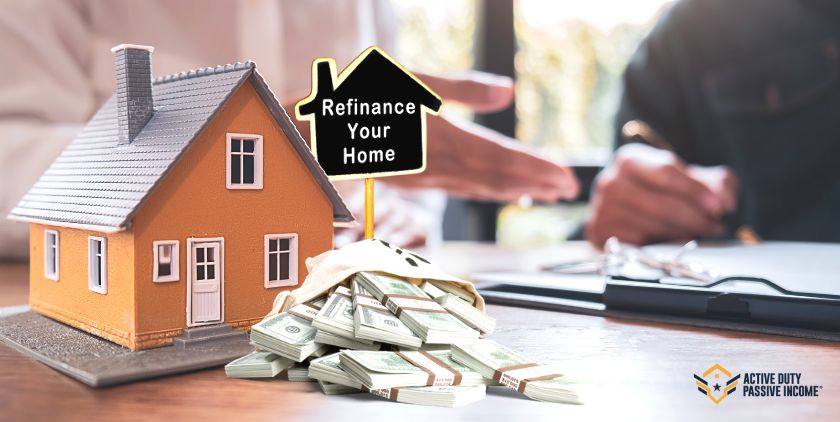Refinancing a VA home loan can be easily accomplished by the owner. There are several reasons why one would need to or want to refinance.
If you’re looking to refinance your VA Home Loan, it does not have to be a stressful process. In this informative guide, we will be covering the ins and outs of the VA home loan refinance program.When looking to refinance an owner should go over their entire financial situation and decide what the purpose of refinancing is as it does cost money, sometimes upfront and sometimes it is added onto the backend of the loan. In the past couple of years many refinances were completed so that owners could reduce their interest rates and their monthly mortgage payments. In the current market we see a lot of people refinancing to get money out of the equity to use the case in another area. Let’s go over a few different types of refinancing and what they can be used for so you can see if this option is something that may be useful to you.
VA Loan Refinance Options
Refinancing your home loan with a VA Loan can help you save thousands of dollars over the course of years. VA loans provide a variety of options to fit your needs and budget such as lower interest rates, lower monthly payments, the ability to cash out up to 100% of the home’s value, or extend the loan term so you can use your savings for other things.
The options you have are:
- VA Streamline Refinance, Interest Rate Reduction Refinance Loan (IRRRL)
- VA cash-out refinance
VA Streamline Refinance
For homeowners who already have a VA loan, the VA streamline refinance option also called a (VA IRRRL) can be a great strategy to pursue.
Here’s why.
-
- No credit check
- No appraisal
- No requirement to currently occupy the residence
This makes it easier and faster to obtain than other options. It’s possible to refi up to 100% of the appraised value of your home. Not only that, but it typically does not require out-of-pocket expenses, reducing the overall cost of obtaining this kind of loan. These costs can all be rolled into the loan. If you’re looking to move fast on a refi this is a great route to take.
Refinancing Strategy, Even if the Rate Goes Up
Let’s talk about this statement “why would anyone want to refinance their mortgage to a higher rate”? Just strategizing with you here and trying to widen your brain when it comes to investing, what if you could reduce the monthly payment by refinancing the entire loan all the way out again by extending the life of the loan. In one example an owner buys a home for 300K and gets their bonus and pays the loan down 100K. In this scenario the owner does not reduce their monthly payments, they are just shortening the life of the loan because they just put more on the loan principal. So in this case the owner could refinance, extend the life of the loan back to 30 years and refinance for what is left on the loan. In one deal I did this and although it does make it where the 30 years is back on it allowed me to lower my risk in my portfolio for when the house is unoccupied because I had already (early in my investing) paid it down. For me a lower monthly payment made it less stressful to cover the property when it was empty and it also created a larger cashflow for me to save for issues that could go wrong! This is just a reminder sometimes in real estate the hesitation to continue to buy more depends on the financial risk you have monthly. So now when I get a loan the investor looks at the payment and sees a much lower risk of a monthly payment and they see the higher cash flow on it! Strategy is key! Education is key!
Here is an example of using a VA streamline utilizing three different interest rates.
| Example Loan Amount
and Rate |
Monthly Estimated payment for Principal and Interest | Total estimated interest over 30 years |
| $250K @ 7.5% | $1,748 | $379,293 |
| $250K @ 7% | $1,663 | $348,772 |
| $250K @ 6.5% | $1,580 | $318,861 |
VA Cash-Out Refinance Loan
A cash-out refi loan is a powerful way to tap into your home’s equity. This type of refinancing allows you to take the difference of the value of your home vs the debt owed on it to take cash out of your property, giving you extra cash to use for any purpose such as repairs, home improvements, paying down debt or even purchasing another property.
An example of this is:
| Home Value | $100,000 |
| Debt Owed | $60,000 |
| Difference | $40,000 |
| Fees With Refinance *Varies | $2,500 |
| Cash Out Amount | $37,500 @ 100% Refinance |
VA Home Loan Refinance Eligibility
To be eligible for the VA IRRRL you have to currently have a VA home loan you want to refinance, regular loans are not eligible for this program. To be eligible for the VA cash-out refinance you have to qualify for a Certificate of Eligibility and live in the home you are refinancing.Your probably asking what is a COE though? A COE is a document that states you meet the requirements set by the VA to refinance your home into the VA backed program. When you go to submit your application the lender will be asking you specific questions to determine if you are eligible and the lender will be looking at obtaining your COE. Dig more into this on our recent blog about COEs!
Service Requirements for the Veterans Affair-Backed Cash-Out-Refinance-Loan
In order to qualify for this loan, there are service requirements that must be met. You’ll need to have served in active duty (for more than 90 days) for any branch of the US Armed Forces and have a valid Certificate of Eligibility (COE). Additionally, current VA borrowers are able to refinance their loan with less stringent requirements than those required for first-time applicants.
Credit Score for VA Refinance
When applying for a VA cash-out refinance loan, the VA does not have a minimum credit score requirement. The lender will have their own specific credit score requirements and generally speaking, a strong credit score is very beneficial in securing the best loan terms and interest rates. Lenders will go over your credit history, and trustworthiness to determine how strong of a borrower you will be. Also, remember unlike some loans when you are doing a VA refinance you can shop around for lenders. This does not have to be the current lender the loan is with! When you are looking into lenders you should focus on their rules and regulations along with the assurance that you will be able to keep the loan in the format you are seeking, such as keeping it a VA loan vs turning it to a conventional loan.
Debt-to-income Requirements
When applying for a VA cash-out refinance loan, the VA requires you to have a debt-to-income (DTI) ratio that is lower than 41%. This means that your total monthly debts can not exceed 41% of your gross monthly income. Having a DTI ratio that falls within this range shows lenders that you are financially responsible. Now with this being said make sure that you have a lender or a couple of lenders look at your overall situation to see what products they can offer. The math can be considered and looked at in different views by different lenders.
Other VA Refinance Requirements
In addition to having a Certificate of Eligibility (COE) and meeting the in-service requirements, there are several other requirements that must be met in order to secure a VA refinance loan. Income verification is required for VA cash-out refinance loans and can be satisfied by submitting copies of W2s and pay stubs from your employer, business, or other income sources. Each lender will have their list of go dos!
VA Refinance Fees
When you refinance with the VA there are a few fees that are involved. One of them is the VA funding fee. It is a one time payment that helps lower the cost of the loan for U.S taxpayers since the VA loan doesn’t require a down payment or mortgage insurance. You don’t have to pay this fee if any of these apply:
- Disabled Veteran status
- Surviving dependency spouse of a Veteran
- Active duty service member with the Purple Heart medal
This funding fee can be wrapped into the loan or you can pay the fee all at once during closing.
VA Loan Refinance Costs
The funding fee can be wrapped into the loan or you can pay the fee all at once during closing. The amount you pay depends on the amount of your loan.
Some other costs you might incur are:
- Origination fee
- Discount points or “buydowns”
- Real estate taxes and insurance
- Title paperwork
- Recording fee
Benefits Of Refinancing A VA Loan
By refinancing to a VA loan here are all of the benefits you can expect:
- Lower than standard interest rates
- Potentially lower monthly mortgage payment (this in an investor’s eyes can also be considered risk)
- No prepayment penalties
- Ability to roll funding fee into the loan
Cons of Refinancing a VA Mortgage
The cons of a VA mortgage are few, but still things you should consider. The funding fee is a giant con as it can amount to thousands of dollars to get this type of loan. Another con is even though the VA has no credit score requirement the banking establishment that you go through will so it defeats the purpose. The last con is finding a lender that will offer these types of programs because not all lenders will and that is something to consider.
ADPI Pro Tips
- Know your options between the IRRRL and the Refinance loan and decide which is best for you.
- Know your costs when utilizing these options and run some numbers on each option.











